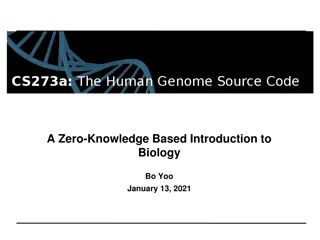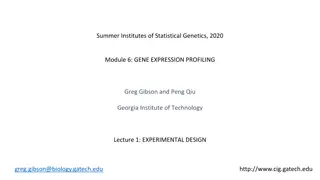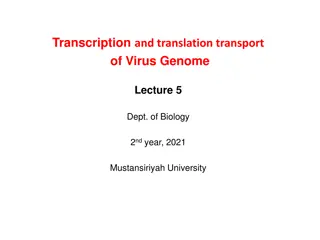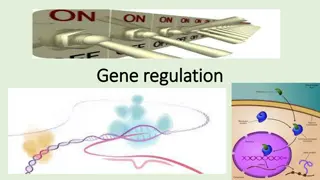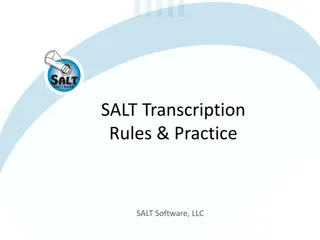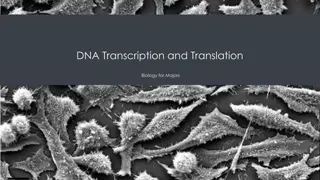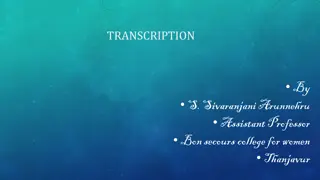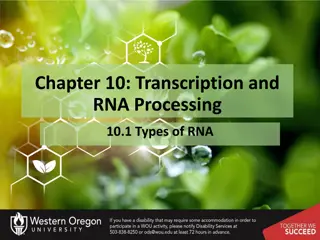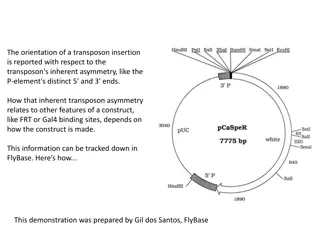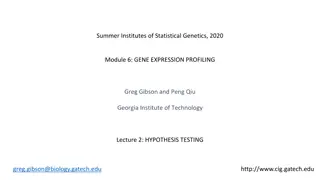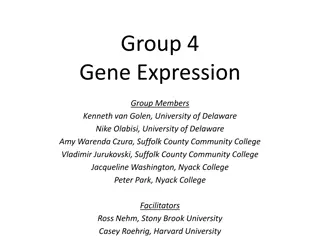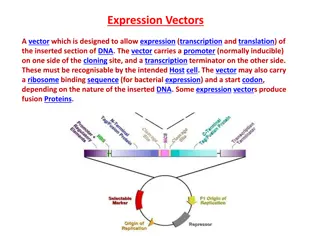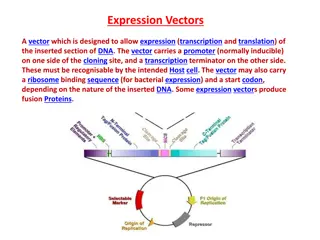Understanding Transcription and Gene Expression in Biology
Explore the intricate process of transcription in biology, where mRNA is synthesized from DNA to carry the genetic code for protein production. Learn about the connection between genotype and phenotype, the role of genes in protein synthesis, and the significance of terms such as RNA Polymerase, intron, exon, splicing, primary transcript, and mature transcript. Discover how gene expression involves both transcription and translation, ultimately influencing an organism's characteristics. Dive into the world of proteins, their synthesis, and the factors that can impact protein production. Unravel the complex relationship between DNA and RNA in the synthesis of proteins, from the nucleus to the ribosome.
Download Presentation

Please find below an Image/Link to download the presentation.
The content on the website is provided AS IS for your information and personal use only. It may not be sold, licensed, or shared on other websites without obtaining consent from the author. Download presentation by click this link. If you encounter any issues during the download, it is possible that the publisher has removed the file from their server.
E N D
Presentation Transcript
Higher Biology Unit 1: 1.3 Transcription
Revision What is an organism s genotype? The genetic code that control its characteristics What is an organism s phenotype? The characteristics possessed by that organism as a result of its genotype
Learning Intentions To be able to describe the stages involved in transcription
Success Criteria I can describe the stages involved in transcription I can explain the importance of the following terms: RNA Polymerase, intron, exon, splicing, primary transcript, mature transcript
Genes A gene is a small section of DNA that carries the code for a particular protein Taking the code from a gene and using it to make a protein is a process known as gene expression Gene expression is a 2 staged process The processes are transcription and translation
Proteins The genotype (order of bases in an organism s DNA) carries the code to make proteins from long chains of amino acids The proteins synthesised are what controls the phenotype of the organism Synthesis of proteins can be affected by intra and extra cellular factors
Protein Synthesis From Nat 5 what molecules/structures are involved in protein synthesis? DNA, mRNA, nucleotides, nucleus, ribosome Where does protein synthesis start? Nucleus Where does protein synthesis finish? Ribosome
Nucleus A G A G G T T G A C G A A DNA T C T C C A A C T G C T T Transcription Overview of gene expression mRNA U C U C C A A C U G C U U codon ser thr pro ala Ribosome Translation Protein
Transcription Transcription is the synthesis of a molecule of mRNA from a stand of DNA mRNA carries the code for proteins from the nucleus to the ribosomes
DNA/RNA comparison DNA (deoxyribonucleic acid) Double Stranded Bases are: Adenine, Thymine, Guanine, Cytosine Base pairing rule Adenine : Thymine Guanine : Cytosine Made of deoxyribose sugar, phosphate and base RNA (ribonucleic acid) Single Stranded Bases are: Adenine, Uracil, Guanine, Cytosine Base Pairing Rule Adenine : Uracil Guanine : Cytosine Made of ribose sugar, phosphate and base
Transcription Transcription of a gene starts at a region of DNA known as the promoter Transcription finishes at a sequence of DNA known as the terminator sequence RNA polymerase is the enzyme responsible for transcription
RNA Polymerase RNA polymerase moves along the DNA start from the promoter sequence to the terminator sequence As it moves along it unwinds the DNA strand This allows free nucleotides to join with their complementary partners The complementary bases form the primary mRNA transcript molecule Nucleotides are added at the 3 end of the mRNA molecule
Primary Transcript The mRNA molecule formed is known as the primary transcript It is made up of regions called introns and exons Exons are regions of the mRNA molecule that will code for the final protein Introns are non coding regions
Splicing The removal of introns and joining together of the remaining exons is known as splicing This results in a mature mRNA transcript being formed which passes out of the nucleus and into the cytoplasm




